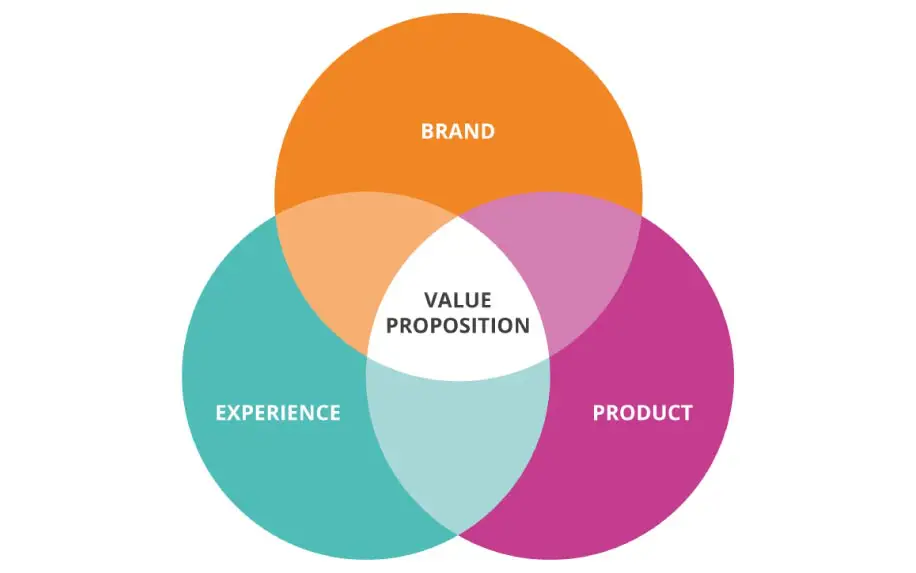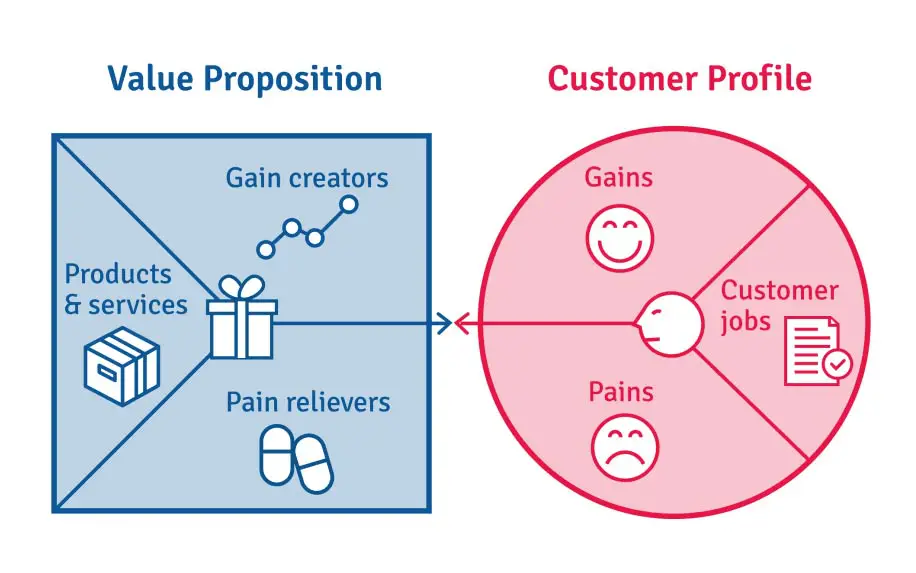A value proposition is a marketing statement for a business. A company uses this statement to illustrate the reasons a potential target group should purchase a product or subscribe to a service. It sounds so straightforward…but vital for your business!
The purpose of a value proposition is to persuade a customer that your one specific product or service will add more value than the other products in that niche. Companies use this statement to target customers who will benefit most from using the company’s products, and this helps maintain economic stability for the business.
A Value Proposition is essential for a business to engage and connect with customers in a meaningful way. The Value Proposition is central to the overall business paradigm. It acts as an anchor for all decision-making, operations, and customer engagement.
In this article, we’ll explore the meaning of value proposition and how you can create value that aligns with your brand’s products/services. Value is the main motivator in consumer purchasing decisions, so it’s important to know to to create and maintain it.
Table of Contents
Value Proposition Meaning
A value proposition is a statement that summarises the key benefits a company’s product or service offers to customers. It conveys how a business solves a problem or improves a situation for its target audience. An effective value proposition is a compelling statement that conveys the core value a business provides its customers in a way that resonates with them. It’s an important tool for positioning a brand, guiding marketing, and making sales.

Value Proposition Definition
According to the Oxford Dictionary, Value Proposition is a marketing term. It refers to “an innovation, service, or feature intended to make a company or product attractive to customers”.
Value Proposition Design
If you’re wondering how to create and design a value proposition for your brand, consider the key factors listed below.
- Value proposition highlights the primary value and differentiation of an offering. This could be solving a common frustration, meeting an important need, or making something easier.
- Effective value propositions focus on the customer, not the product or service. They speak to the outcomes and experience customers get.
- Strong value propositions are clear, concise, and meaningful. They use language and ideas that resonate with the intended audience.
- Value propositions can be tailored for different customer segments to emphasise the most relevant values.
- They should be prominently featured in marketing materials and sales conversations to convey value quickly.
- Value propositions evolve over time as customer needs change and new differentiators emerge. They are not static.
Creating value proposition needs to be a customer-centric approach, it has to align with their needs and resonate within their life. Check out some examples of value propositions listed below to help inspire you.
Customer Value Proposition Examples
There is no straightforward method for identifying and creating a value proposition for your brand. It is entirely unique to what you provide and where your place is in the market. You can, however, check out some examples of value propositions, it will help you understand how mission statements and marketing taglines can be used to build brand identity and even guide business decisions.
IKEA’s Value Proposition
IKEA is one of the most successful businesses in the world. The company employs more than 100,000 individuals in more than 50 countries worldwide and ranks among Forbes’s Top 50 of the World’s Most Valuable Brands. IKEA’s growth largely stems from its forward-thinking strategy and the construction of a well-organised global network, from production to distribution.
Ikea’s value proposition also plays a key role in its success. Their business plan is,
“to offer a wide range of well-designed, functional home furnishing products at prices so low that as many people as possible will be able to afford them.”
This strategy gives the company a competitive advantage and a clear vision of what it wants to achieve, guided by strong values. Here are a few of IKEA’s strong points that have pivoted the company into the forefront of the world market.
- Pricing,
- Sales outlets,
- Personal visits,
- Sustainability,
- Staff.
Marketing is essentially delivering value to the customer in the most efficient and effective way possible so they will want to take action.

To communicate value, you need everyone who works on your marketing campaigns to have a clear understanding of your value proposition. This applies not just to your company as a whole, but to every action you desire a customer to take.
From a consumer’s perspective, IKEA’s value proposition is clear and easily summarised. They offer cheap, durable and fashionable furniture at a low price. This comes with the novelty of self-assembly, due to Ikea’s flatpack format. In other words, people flock to Ikea because they have a clear understanding of what’s on offer. When customers have a clear picture of the value you can offer, they can make an informed decision about the value it proposes to them.
Uber Value Proposition Example
Uber Technologies Inc. is a global ride-sharing platform that connects riders with drivers through its mobile app. Founded in 2009 by Travis Kalanick and Garrett Camp in San Francisco, Uber has since expanded its services and global footprint dramatically.
“Tap a button, get a ride.”
At its core, Uber’s value proposition revolves around simplicity, convenience, and efficiency. They address a common problem many urban dwellers and travellers face: the need for quick, reliable, and convenient transportation. Whether you’re without a car, in a foreign city, or simply need a ride after a night out, Uber provides a solution.
While Uber might not always quantify its benefits in numerical terms in its marketing, the underlying value is clear:
- No more waiting indefinitely for a taxi. With Uber, you can see where your ride is and how long it will take to reach you.
- In many cases, especially with options like UberPool, rides can be more affordable than traditional taxis or car services.
Uber’s value proposition promises a modern, tech-driven, and user-friendly approach to transportation, setting it apart from traditional taxi services and other modes of public transport. This marketing message also reinforces the fact that Uber operates in numerous cities and countries around the world, making it a familiar choice for travellers that they can rely on, or in other words, “Tap a button, get a ride”.
Dollar Shave Club
Dollar Shave Club is a subscription-based company that sells razors and other shaving products directly to consumers. They offer a convenient, affordable way for men to get high-quality razors regularly delivered to their door. Their motto is
“A great shave for a few bucks a month.”
Dollar Shave Club clearly conveys its primary value – affordable and convenient razors. It’s a simple statement, but it underpins their entire business ethos. They have disrupted the razor industry by offering a flexible, cost-effective subscription model directly to consumers. This, combined with a viral marketing strategy has attracted a large base of loyal customers.
Amazon Prime
Amazon Prime is a subscription service offered by Amazon, one of the world’s largest online retailers. Over the years, Amazon Prime has evolved and expanded its offerings, making it a multifaceted service with a broad value proposition.
The current mission statement/slogan is,
“There’s more to Prime. A truckload more.”
Here’s an overview of Amazon Prime and its value proposition:
Free Two-Day Shipping (and sometimes faster)
One of the initial and most popular features of Amazon Prime is the free two-day shipping on eligible items. In some areas, members can even get same-day or one-day delivery at no additional cost.
Amazon Prime Video
Prime members have access to a vast library of movies, TV shows, and Amazon Original series. This competes with other streaming services and adds significant value for those who enjoy watching content online.
Amazon Prime Music
Members can stream a growing selection of two million songs, all ad-free. There’s also a discount for subscribing to Amazon Music Unlimited, which offers a more extensive library.
Prime Reading
This feature gives members access to a rotating selection of eBooks, magazines, comics, and more. It’s like having a digital library that you can access anytime.
Amazon Photos
Prime members get unlimited photo storage in the Amazon Cloud, which is a great value for those who take a lot of pictures and need a reliable place to store them.
Amazon Family & Prime Pantry
These features offer discounts on family-oriented products and groceries, respectively. Prime Pantry allows members to shop for groceries and household products and have them delivered right to their door.
Early Access to Deals
Members get 30-minute early access to Lightning Deals on Amazon, which can be crucial for snagging popular items that may sell out quickly.
Prime Wardrobe
This “try before you buy” fashion shopping experience allows members to choose clothing, shoes, and accessories to try on at home before purchasing.
Amazon Fresh & Whole Foods Discounts
In some areas, Prime members can shop for groceries with Amazon Fresh. Additionally, in the U.S., Prime members can get discounts at Whole Foods Market stores.
Prime Now
In select cities, members can get delivery of thousands of items in as little as an hour or two, ranging from household items to food delivery.

The core value proposition of Amazon Prime revolves around convenience, savings, and entertainment. For a set annual or monthly fee, members get a suite of benefits that would individually cost much more. The service is designed to make shopping faster, cheaper, and more enjoyable, while also providing a host of entertainment options.
For many, the convenience of fast shipping and the added entertainment options make the subscription fee worth it. Additionally, the more services a member uses, the more value they get from their membership. It’s worth noting that the availability of some features can vary based on geographic location and local regulations, but for the most part, there is a lot to owning a Prime membership.
Value Proposition Canvas Example
Here is an example of how to use the Value Proposition Canvas to define and communicate a proposition. Follow these steps to help you identify the USP and hat it means to your target audience.
Customer Profile
This helps you create a customer profile to better understand your target audience and their motivations. It consists of:
Customer jobs
What tasks customers are trying to accomplish in their daily lives, e.g) stay fit and active, lose weight, etc.
Pains
The challenges or obstacles that customers face while trying to accomplish these jobs, e.g.) finding time to get to the gym, expensive gym memberships, difficulty staying motivated to workout at home
Gains
The benefits or outcomes that customers hope to achieve, e.g.) get in better shape, feel more confident about their body, have more energy, etc.
Value Map
This section describes how the product or service addresses the customer’s needs. It consists of
Products/Services
The actual products or services the business offers, e.g.) on-demand, live-streamed workout classes.
Pain Relievers
How the product/service alleviates customer pains, e.g.) workout anytime from home, affordable monthly price, access to a variety of class types.
Gain Creators
How the product/service creates gains for the customer, e.g.) get fit without the gym, feel motivated by trainers and other users, and see results and progress.
Value Proposition Statement
Putting it together,
“Our on-demand fitness app provides affordable, convenient access to unlimited workout classes that you can stream anytime, anywhere. Stay motivated and get the results you want with guidance from our world-class trainers.”
Key Takeaways:
- Identifies customer jobs, pains, and gains
- Maps company offering to customer pains and gains
- Clearly articulates the primary value and benefits provided
By following this methodology, you can create a value proposition tailored to your customers’ needs and perspectives. This example illustrates how it enables customer-focused value messaging.
The goal is to ensure that the Value Map aligns closely with the Customer Profile. In this example, the fitness app is designed specifically to address the needs and wants of busy professionals, offering solutions that match their lifestyles and preferences.
The Four Elements of a Value Proposition
So what makes a great value proposition? Obviously, clarity is one thing, but there’s no sense in having a clear value proposition if it doesn’t appeal to anyone. Finding value may require a great deal of soul-searching about what makes your business uniquely attractive, and most of the time it’s just about putting yourself in your customer’s shoes.
Value typically revolves around a handful of variables, including:
- Price,
- Quality,
- Features,
- Service,
- Values.
For example, your value proposition might simply be that you offer the best product at the lowest price. Alternatively, you might offer features that no one else is able to.

The above graph demonstrates how you can identify value. Your value proposition is at the intersection of your brand, product, and customer experience. Keep reading for more guidance on how to create a value proposition using four different elements.
1. Primary Value Proposition
Your company needs a primary value, which is the answer to the question:
“Why should people buy from you rather than your competitors?”
What is it that you offer that no one else can? This is easier to answer with an established business, as you already have a track record of offering great products and services to customers. Therefore, you know what they like. However, if you’re launching a new business, you’ll have to research existing companies to find a gap in the market.
2. Prospect-Level Value Proposition
This indicates the prospects you are targeting with your marketing. For each prospect, you should answer this question:
“Why should this targeted customer buy from you rather than any of your competitors?”
If you work with a small number of high-value clients, it’s easy to tailor your value proposition to each of these, as you have a clear understanding of their needs and pain points. If you cast a wider net though, you’ll need to come up with some ideal customer personas instead.
3. Product-Level Value Proposition
Now that you’ve identified your target market, you need to define the products and/or services you intend to sell them. Each product requires its own value proposition, which you can craft by answering this question:
“Why should X buy this product rather than any other product?”
Let’s consider the Ikea value again. Their overarching USP is getting quality products at a fair price. However, what this means for a sofa will be quite different to what it means for a wooden spoon. So it’s important to understand how true-to-life your mission statement is from the perspective of a customer.
4. Process-Level Value Proposition
Once you’ve identified a target market for each product you’re trying to sell, you have to craft a value proposition for each specific product, you should also have a picture of the purchasing journey for each of your products. Ask yourself this,
“What information do customers need at different stages of the buying process?“
To return to our example with Ikea’s value propositions, customers don’t need much convincing to buy a wooden spoon. Really, you can place it in a prominent position in the store, and customers who need one will pretty much just pop it in the trolley.
For something more expensive like a bed, a sofa or even a kitchen, consumers need more information. The selling process might therefore include content marketing, traditional advertising or customer testimonials to push the value proposition.

It’s important to match your value to your ideal customer personas. Understand that some products will require more resources to showcase their value to customers, whilst others, not so much.
Benefits of a Value Proposition
A strong value proposition provides critical benefits spanning marketing, sales, innovation, and strategy by distilling why customers should choose your offering. It’s an essential tool for business success and growth. Here are the benefits of discovering, articulating and realising your brand’s unique value.
Providing Direction
Whether you are just starting your business, or have an established company, you need to be clear about your value proposition. Otherwise, you may develop a product or service that fulfils your own desires but not those of your target market.
A Value Proposition gives direction by first identifying a target audience, and then defining a need that you can quench with your strategic solution. A value proposition sets a direction for product development and marketing efforts by defining the primary customer value you want to highlight.
Creating Focus
The value proposition directs your marketing efforts toward activities that will engender the best outcome. It gives marketers and salespeople a consistent messaging foundation, guiding content creation and influencing market positioning.
By understanding your targeted customers and the need that you’re attempting to solve, you’re able to concentrate on the most relevant activities, which will enable you to clearly communicate the benefits and advantages of your brand’s solution.
Providing a Clear Message
A Value Proposition provides a framework for the strategy you are using to generate value for your audience as well as an explanation as to why your solution is better than that of others. It provides a clear message. Especially as a start-up without any brand recognition, you’re going to have to create a very clear picture as to why you’re worth people’s time.
Increases Marketing Effectiveness
A Value Proposition is essential for a business to engage and connect with customers in a meaningful way. It is central to the overall business paradigm, acting as an anchor for all decision-making, operations, and customer engagement decisions.
A compelling value proposition also piques customer interest and draws them in by clearly articulating the problems solved and benefits received. It demonstrates an understanding of your customer needs, establishing credibility and trust with target audiences.
Differentiates vs. Competitors
An effective value proposition highlights unique strengths and differentiators from competing options customers have. When core customer values are clearly conveyed, it becomes easier to convince prospects to buy your products or services, as you offer a better solution.
Remember, a value proposition is essential for a business to engage and connect with customers in a meaningful way.
The value proposition is central to the overall business paradigm. It acts as an anchor for all decision-making, operations, and customer engagement.
Learn more about digital value propositions here.


